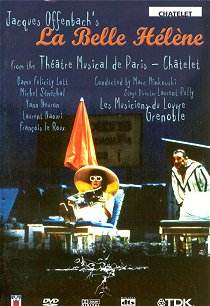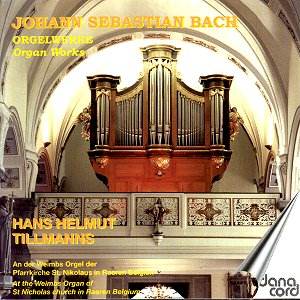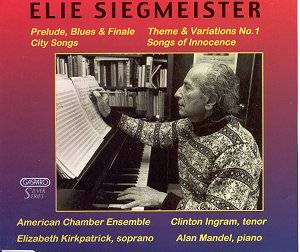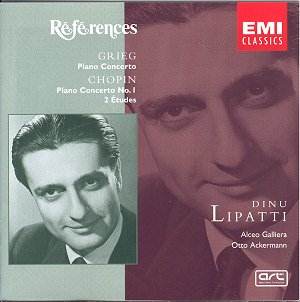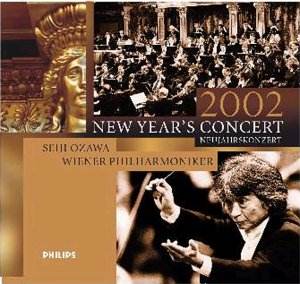 Composer: Johann Strauss II, Josef Strauss, Joseph Hellmesberger II
Composer: Johann Strauss II, Josef Strauss, Joseph Hellmesberger II
Works: Ouvertüre Die Fledermaus, Künstlerleben, Walzer op.316, Zivio! Marsch, op.456, Die Schwätzerin, Polka Mazur, op.144, Vorwärts! Polka schnell, op.127, Aquarellen, Walzer, op.258, Die Libelle, Polka Mazur, op.204, Plappermäulchen! Polka schnell, op.245, Danse diabolique, Elisen-Polka française, op.151, Wiener Blut, Walzer, op.354, Tik-Tak, Polka schnell, op.365, An der schönen, blauen Donau, Walzer, op. 314, Radetzky-Marsch, op. 228
Performers: Wiener Philharmoniker, Seiji Ozawa
Recording: Live at the Musikverein, Wien on 1st January 2002
Label: Philips 468 999-2
Seiji Ozawa’s return to the podium of the Wiener Philharmoniker for the New Year’s Day concert marks a noteworthy chapter in the history of these illustrious celebrations. Following a hiatus since Riccardo Muti’s tenure, Ozawa’s leadership in this vibrant tradition is both a nod to the past and a fresh perspective on the Strauss legacy. This recording, featuring a bouquet of familiar waltzes and polkas from the Strauss family, encapsulates the celebratory spirit of Viennese culture while inviting scrutiny of interpretative choices that may polarize traditionalists and modernists alike.
The concert opens with the Ouvertüre from Die Fledermaus, a piece that sets the tone for the festivities. Ozawa’s approach is characterized by vibrant dynamics and brisk tempos, capturing the dramatic flair inherent in Strauss’s operetta. The Wiener Philharmoniker, with its unparalleled blend of warmth and precision, responds beautifully, revealing a tapestry of orchestral color that is both bold and nuanced. The transition to Aquarellen, a personal favorite of Ozawa, showcases the orchestra’s ability to produce shimmering textures, with phrasing that is both delicate and expansive, highlighting the conductor’s interpretative prowess.
Yet, not all moments resonate equally. Ozawa’s reading of An der schönen, blauen Donau, while undeniably lush, suffers from a somewhat excessive reliance on a non-Viennese rubato. This stylistic choice, though intriguing, disrupts the natural flow of the waltz, leading to moments that, while beautiful, lack the charm and spontaneity that one expects from this iconic piece. The performance becomes a study in contrasts, as the elegance of Wiener Blut reflects a more traditional adherence to the score’s inherent rhythms, demonstrating the orchestra’s ability to unite under Ozawa’s varied interpretative vision.
A standout moment arises with Hellmesberger’s Danse Diabolique, a delightful rarity that adds an unexpected depth to the program. Its intricate rhythms and virtuosic demands reveal the orchestra’s technical mastery, with each section contributing to a performance that is both spirited and refined. The Polkas and Mazurkas, particularly Plappermäulchen, demand a playful touch which the orchestra delivers with effortless agility, a testament to their collective musicianship.
The Radetzky-Marsch, a staple of New Year celebrations, elicits enthusiastic audience participation, echoing the historical context of its premiere. However, Ozawa’s ability to command the audience’s response lacks the iron authority of a Karajan, resulting in a somewhat chaotic rendering that reflects a shift in audience dynamics reminiscent of contemporary concert culture. Yet, the genuine joy exuded by the performers clearly resonates with the audience, an affirmation of the celebratory ethos that characterizes these concerts.
Philips’ engineering captures the vibrancy of the live performance exceptionally well, allowing the rich sonorities of the orchestra to shine through. The production is complemented by a lavishly illustrated booklet, adding a visual dimension that invites listeners into the heart of the festivities.
With a mix of compelling interpretations and moments of hesitation, this New Year’s concert under Ozawa’s baton is a reflection of both the enduring legacy of the Strauss family and the evolving nature of orchestral performance in contemporary contexts. While it may not reach the heights of the legendary concerts under Karajan or Kleiber, it stands as a testament to the infectious spirit of Viennese music-making, leaving its own unique imprint on the annual tradition. The enthusiastic reception in Austria suggests that, for many, Ozawa’s interpretation resonates meaningfully, establishing a new benchmark for the New Year’s celebration in the 21st century.
